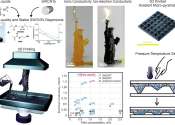Ionic liquids, originally known as liquid electrolytes, ionic melts, ionic fluids, fused salts, liquid salts, or ionic glasses, are liquids comprised predominantly of ions and ion-pairs at some given temperature. Ordinary table salt, or, sodium chloride, consists of sodium cations (Na+) and chloride anions (Cl−) that when heated to several hundred degrees, forms a liquid containing predominantly ions. While many combinations of bulkier and often more asymmetric organic ions also form well defined crystals, with well defined melting points, many instead form glasses prior to thermodynamically stable crystal lattice formation where the cyrstallization kinetics are extremely slow. For example, the salt 1-ethyl-3-methylimidazolium dicyanamide, [C2mim][N(CN)2], melts at Tm = -21 °C, pyridinium chloride, [PyH]Cl, exhibits a melting point of Tm = 144.5 °C but 1-butyl-3,5-dimethylpyridinium bromide, [N-butyl-3,5-dimethyl-Py]Br, exhibits glass formation at Tg = -24 °C.
The term, ionic liquid, includes all classical molten salts, which are comprised of more thermally stable ions, such as sodium with chloride or potassium with nitrate, and has been attested as early as 1943. Recently, it has come to be used for salts whose melting point is below an arbitrary set point of 100 °C. There also exist mixtures of substances which have low melting points, called deep eutectic solvents, or DES, that have many similarities with ionic liquids.









